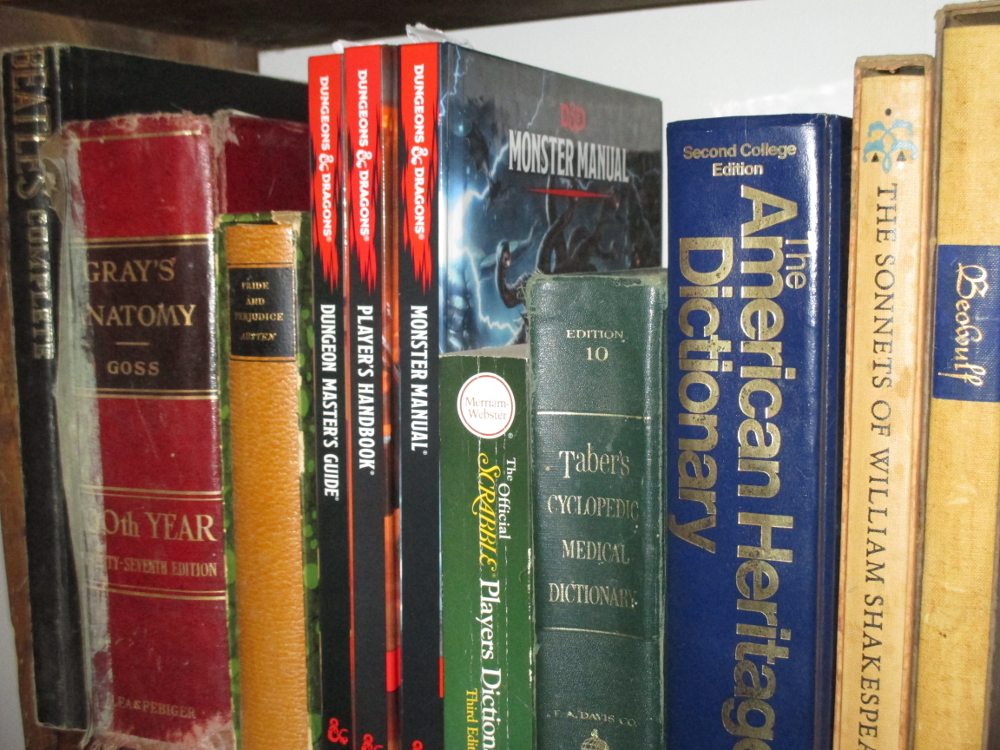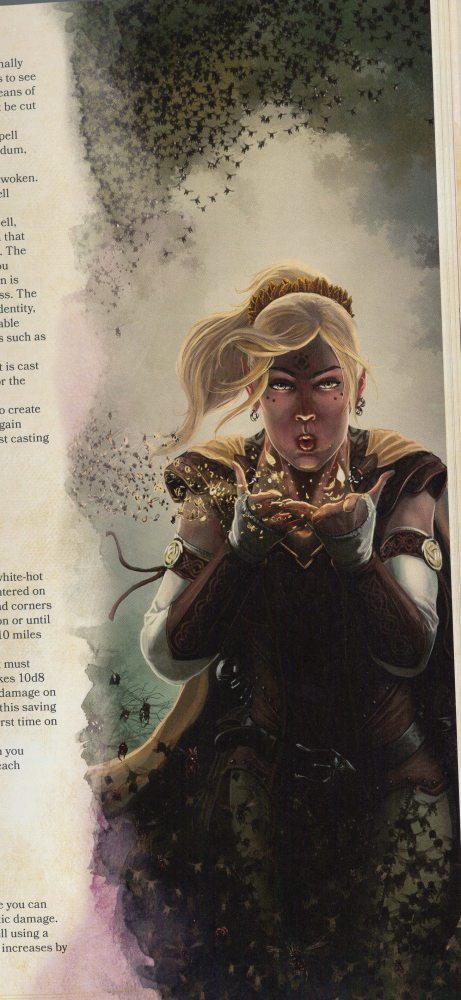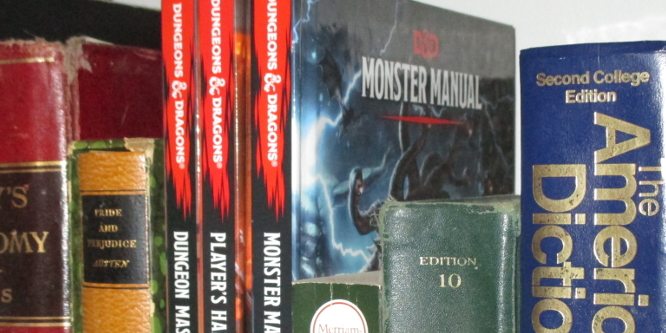Happy first birthday, Dungeons & Dragons fifth edition: I feel like a little celebration is in order.
I got back into D&D about five years ago, after something like 25 years away from the game. (I had the original red box, a couple modules, and the Fiend Folio back in middle school – and just one friend who shared my interest in the game. Truth be told, most of our enjoyment was in reading the materials and creating characters just for fun.) Since last summer’s launch, I’ve played one complete fifth edition adventure and a short one-shot, and my wife and daughter and I are two sessions into our first 5e game as a family.
I’m a big fan of the new iteration of the game, and I regularly find myself picking up the three core books – the Player’s Handbook, Monster Manual, and Dungeon Master’s Guide – not for actual game-related reasons, but just for some non-screen brain-stretching time. And what’s occurred to me is that one of the unsung accomplishments of Wizards of the Coast is the development of this three-volume set in such a way that the books can be enjoyed and appreciated by geek families who’ve never even played – or may not even want to play – D&D.
These books just feel like they belong on geek family bookshelves, even if you and your kids will never roll a d12. It’s kind of comparable to keeping The Encyclopedia of Science Fiction handy; or The Atlas of Middle-earth; or a volume of movie poster art; or the Scrabble dictionary. They seem like far more than just a detailed set of game rules and guidelines.

There are a couple factors at work here. One big part of it is an emphasis on storytelling, not just within the framework of the game itself, but in Wizards’ approach to the books and world building. For instance, look at the storytelling focus of 5e in comparison to some of the earlier editions:
The Dungeon Master’s Guide includes a “flavors of fantasy” section discussing approaches like heroic, mythic, dark fantasy, intrigue, swashbuckling, and wuxia. There’s a whole chapter on creating a multiverse, detailing different planar categories and arrangements, portals, and inter-planar travel. The “Creating Adventures” chapter dives into the elements of a great adventure, exploring elements like story structure, foreshadowing, and what goes on in between adventures.
Now consider the Player’s Handbook.
Here’s how the first edition Advanced Dungeons & Dragons version of the book introduces the Ranger character class:
Rangers are a sub-class of fighter who are adept at woodcraft, tracking, scouting, and infiltration and spying. ….A ranger must have strength of not less than 13, intelligence of not less than 13, wisdom of not less than 14, and a 14 or greater constitution. …It should also be noted that rangers get 11 hit dice rather than the 9 of other fighter-types.
As a reference specifically for the D&D player, it works well enough, but after that first sentence, there’s little there to connect with a casual reader. (Later editions – 3.5 and 4e, for instance – began nodding toward the story details and roles of character classes, using brief sample quotes from a ranger, for instance – but again, these still feel very much “in the context of the game.”)

In contrast, the fifth edition Player’s Handbook opens each character class description with a narrative approach:
Rough and wild looking, a human stalks alone through the shadows of trees, hunting the orcs he knows are planning a raid on an nearby farm. Clutching a shortsword in each hand, he becomes a whirlwind of steel, cutting down one enemy after another.
After tumbling away from a cone of freezing air, an elf finds her feet and draws back her bow to loose an arrow at the white dragon. Shrugging off the wave of fear that emanates from the dragon like the cold of its breath, she sends one arrow after another to find the gaps between the dragon’s thick scales.
And there’s that appeal and inspiration to someone who has no clue what dexterity or dodge rolls mean.
In exploring player character development, the fifth edition makes nice use of referencing the Dragonlance and Forgotten Realms characters of Tika Waylan and Artemis Entreri, who may be familiar to fantasy readers: “both humans, both fighters, (with some experience as rogues)” but still very different in background and personality details – all the things that bring a character to life.”
I also really like the Handbook‘s page on “The Weave of Magic” – one of the neatest descriptions of magic I’ve come across, and a good introduction to the second thing I love about these books: The in-depth background material and its presentation.
Raw magic is the stuff of creation, the mute and mindless will of existence, permeating every bit of matter and present in every manifestation of energy throughout the universe.
Mortals can’t directly shape this raw magic. Instead, they make use of a fabric of magic, a kind of interface between the will of a spellcaster and the stuff of raw magic.
… casters have varied ways of naming and visualizing this interface. By any name, without the Weave, raw magic is locked away and inaccessible; the most powerful archmage can’t light a candle with magic in an area where the Weave has been torn.
Whenever a magic effect is created, the threads of the Weave intertwine, twist, and fold to make the effect possible.
Now, when it comes down to it, you don’t need to know all that to play the game. But by laying all that out, the game creators not only fortify the game’s storytelling capacity, but create a neat little background definition of magic that holds its own place in the larger fantasy genre.
The magic chapter also includes a practical illustration of a gnome with a chalkboard explaining spell points of origin, and the spell lists serve as a fine guide to magic that has analogs outside of D&D, like Mage Hand and Polymorph.
You’ll find excellent lists in the Player’s Handbook appendices, of deities from both the D&D and fantasy-historical pantheons, and guides to the planes of existence, all of which support the world-building and have ties to stories and concepts beyond the confines of the game.
In the same vein, the Dungeon Master’s Guide‘s chapter on treasure is a wonderful collection of imaginative items, from things that have entered wider common usage, like the Bag of Holding, to Horseshoes of a Zephyr. And hey, it can be educational, too: I learned what a mangonel is!

The Monster Manual may be the best-suited as a complete stand-alone book if you’re talking strictly reference material. If you’ve got fans of fantastical beasts in your house, you really need a copy of this around, even if you’re not a D&D family.
The classics – ogres, golems, minotaurs, mummies, giants, unicorns, and vampires, to name a few – are in here, as well as page after page of creatures born within the realms of D&D, like the ever-popular beholder on the cover. (I’m also glad to report it includes five of my Fiend Folio favorites: Grell, Slaad, Flumph, Shadow Demon, and Githyanki. Now, where are my Flail Snail, Gorbel, Lava Children, Penanggalan and Sussurus?)
This book also nicely fulfills its “& Dragons” promise: More than 30 pages address their varieties, lairs, and habits.
Which gets me back to the whole imagination-sparking potential of this geekcyclopedic trio. “Mom, what’s a manticore?” “Here – look it up.” And then maybe you keep flipping pages on to learning about Medusa and merfolk and mind flayers.
There’s stuff in here that’s good to know, fun to explore, and perfect for expanding horizons and creativity. There are stories and ideas and inspirations galore. And the artwork! From armor and weapon detail sketches to neatly studious renderings of dragon heads, and suitably shuddery paintings of a baba yaga and gibbering mouther, if you’re a fan of this kind of work, you could practically enjoy these as coffee-table art collections.

None of this is meant to downplay the awesomeness of D&D 5e as a game, of course: There’s a reason these three books earned a total of seven 2015 ENnie nominations, and the fifth edition as a whole earned more than a dozen.
In the audio version of his book The Happiest Days of Our Lives, Wil Wheaton talks about digging out his old role-playing books when he needs a little creative boost, and that’s come to mind over and over again in the time I’ve spent in the pages of these D&D books, completely independent of game play and preparation.
If you’ve never made room on your shelves for them, it’s time.
Disclosure: Wizards of the Coast provided these Dungeons & Dragons materials to GeekDad for review purposes.




Well yes they almost had to, they needed to teach people how to think and be creative. Most folks now a days can not create an independent thought or idea without being told what it is. Even then it needs to be carried out to the nth degree as we are use to having the world handed to us by google, bing and the internet in general. Also if we think something that is unpopular we are then looked down upon or scorned. So it must be perfect or we will not even go there. I have seen this in the “New Management” by the younger generation, ask as many people as you can and take the average for you response. Then blame it on one of them if it ends up being the wrong decision.
Don’t get me wrong, I love the new system both as a player and a GM. I have been playing since AD&D, so I have a bit of experience in all the systems with the exception of 4. And a few that are outside the WotC domain. So far it seems to be just what we have been asking for for years. But only time will tell with what other material they bring out to goof it up.
Dude. D&d with the wife and kid is so cool! I haven’t got the wife into it yet. But.i went through three old school “missions” with my daughter. I think it’s great to get the kids of today into the idea of something that uses their brains and allows for people to do something face to face! That builds interpersonal skills
Nice write up. I have been out of D&D since about 1993. I started in 1981. I have been thinking about starting up again, but I don’t have any players in my area (it looks as if they play Pathfinder here, which I don’t know). So maybe I’ll put up a group on Meetup. I wouldn’t mind just two or three players – something more intimate.
So D&D 5 is a good game, granted you never play the game, only read the descriptions. That looks more like a really bad game, actually.
They burnt me bad with 4th edition, I quit table topping altogether and I used to be a professional gm meaning I got paid to play this game in my tiny town but fourth edition was just terrible. Every character was the exact same and it took hours to whip up a new character despite all of the powers basically doing the exact same thing! The magic of putting together a great character and doing your research was gone, it was homogenous blehhhh. If I wanted Warcraft, I’d play warcraft, I played D and d because the characters and stories felt like they were mine and my friends.
I’m hopefully starting a new star wars d20 campaign soon after 5 years of not playing. I’ve heard good things about fifth edition but they’ve been told to me by people basically paid to tell me good things about fifth edition. Maybe I’ll come back and give it a shot, my favorite books for bookshelf eye candy was actually the magical compendiums and of course the monster manuals.
We’ll see I guess, maybe I’m just getting too old for dungeons and dragons but I look forward to playing with my kids someday.